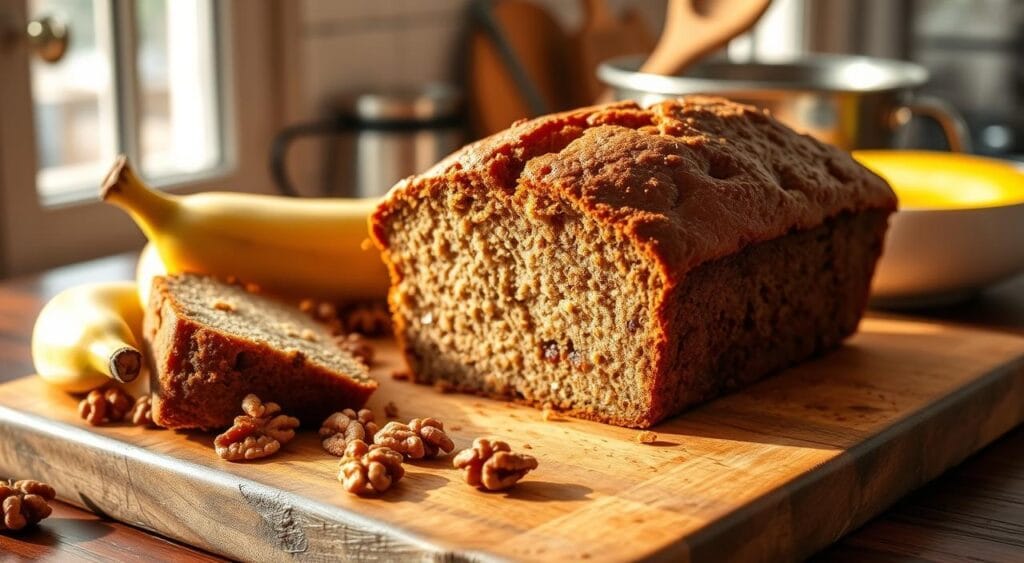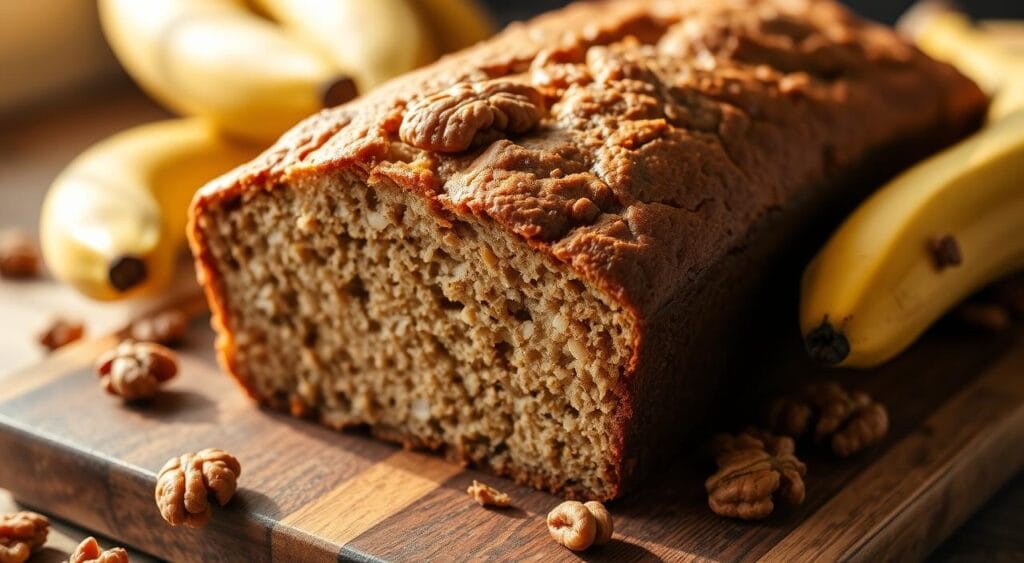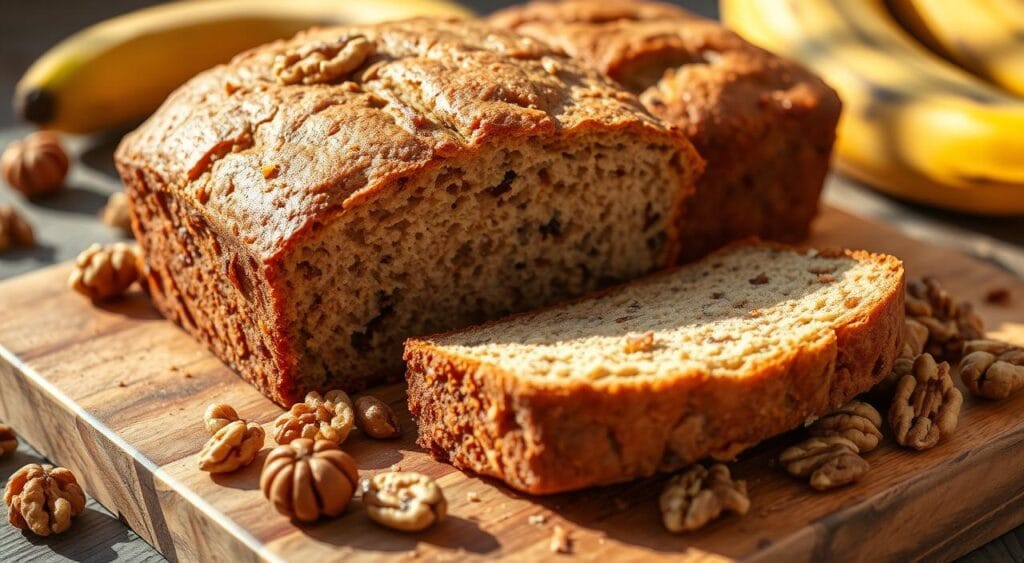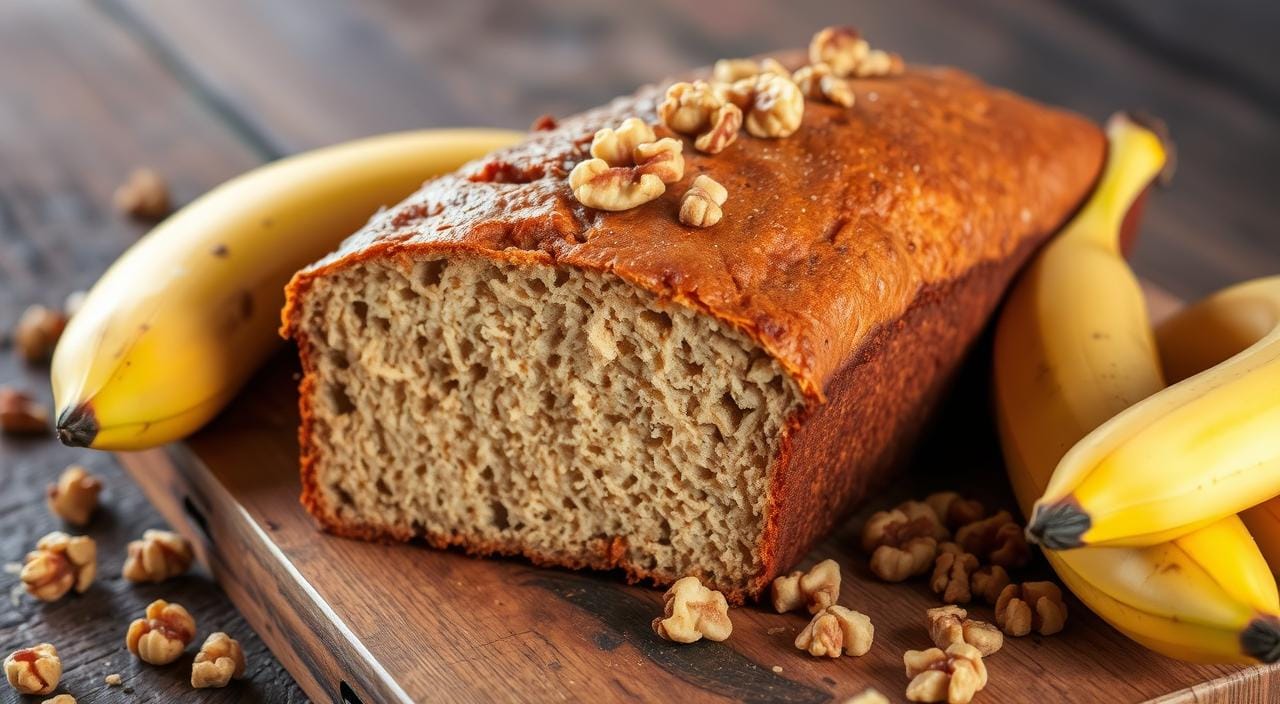Want a tasty and moist homemade treat? Try making banana nut bread. It’s a favorite in many American homes. It’s easy to make and needs just a few ingredients.
Its natural sweetness and nutty taste make it perfect for a homemade dessert. For more baking ideas, check out a homemade recipe website.
Key Takeaways
- Prep Time is 10 minutes, and Cook Time is 1 hour, making it a quick and easy recipe to follow.
- The recipe serves 10 people, with each serving containing 350 kcal and 45g of carbohydrates.
- Using very ripe bananas increases moisture retention in the bread, making it a moist and delicious homemade treat.
- The bread can be stored at room temperature for up to 5 days or frozen for up to 3 months when wrapped properly.
- The recommended oven temperature is 350°F, with a baking time of 35 to 45 minutes for loaves or 24 to 28 minutes for muffins.
- The recipe includes 1 cup of chopped walnuts, which can be omitted or substituted with other nuts for a different flavor.
- The total yield is 2 loaves (8×4 inches each) or approximately 18 muffins, making it a great option for large gatherings or events.
The History of Banana Nut Bread
Banana nut bread has a rich history that started in the late 19th century. This was when bananas first came to the United States. They quickly became a key ingredient in many recipes, including bread.
The first banana bread recipe was in Pillsbury’s 1933 cookbook. It was simple, with mashed bananas, flour, sugar, and nuts. This recipe set the stage for the bread’s popularity.
In the 1930s, banana nut bread became a favorite in American homes. It was made with homemade bananas and nutty flavors. The Great Depression helped it grow, as it used up bananas that were too ripe.
Over time, banana nut bread has changed. Now, you can find banana raisin, chocolate chip, and nutty versions. It’s still loved worldwide, thanks to its history and cultural importance.
Origins in American Baking
Banana nut bread started in American baking in the early 20th century. It quickly became popular because it was easy to make. The use of homemade bananas and nutty flavors made it a favorite.
Evolution Through the Decades
As years went by, banana nut bread evolved. The 1950s brought banana-nut loaves, perfect for families. The 1970s added flavors like vanilla and almond, showing a shift in taste.
Cultural Significance
Banana nut bread has become a cultural icon. It’s served at family events and special occasions. Its homemade and nutty qualities have made it a favorite globally.
Essential Ingredients for Perfect Banana Nut Bread
To make a delicious banana nut bread, you need the right ingredients. The quality and amount of these ingredients matter a lot. Experts say you need mashed bananas, sugar, oil, eggs, and flour for the best bread.
Very ripe mashed bananas are key for banana nut bread. You’ll need 1 ½ cups, which is about 3 large or 4 medium bananas. Using the right amount of bananas is crucial for the perfect flavor and texture.
Other important ingredients include 2 cups of all-purpose flour, ¾ cup of granulated sugar, and 1/2 cup of melted unsalted butter. You’ll also need 2 eggs and 1 teaspoon of pure vanilla extract. Plus, 1 cup of chopped pecans or walnuts adds a crunchy texture and nutty flavor.
Don’t forget 1/2 teaspoon of salt, 1/2 teaspoon of baking powder, and 1 teaspoon of cinnamon. These ingredients make the banana nut bread moist and flavorful, perfect for any time.
Here’s a quick list of what you need:
- 1 ½ cups of mashed very ripe bananas
- 2 cups of all-purpose flour
- ¾ cup of granulated sugar
- 1/2 cup of melted unsalted butter
- 2 eggs
- 1 teaspoon of pure vanilla extract
- 1 cup of chopped pecans or walnuts
With these ingredients and a simple recipe, you can make a delicious banana nut bread. It’s sure to be a hit with anyone.
Choosing the Right Nuts for Your Bread
When picking nuts for banana nut bread, you have many choices. Nuts bring a nutty flavor and texture. Walnuts and pecans are favorites, but you can try other nuts too.
Some like walnuts’ strong taste, while others prefer pecans’ milder flavor. Toasting nuts can enhance their taste and smell. It’s a simple step to improve your bread.
Walnuts vs Pecans
Walnuts and pecans are full of healthy fats and proteins. They can keep you full for up to 4 hours. Choose based on texture and flavor you want in your bread. Walnuts are coarser, while pecans are smoother.
Toasting Techniques
To toast nuts, spread them on a baking sheet. Bake at 350°F for 5-10 minutes, until fragrant and lightly browned. Or, toast them in a skillet over medium heat, stirring often to avoid burning.
Alternative Nut Options
You can also use almonds or hazelnuts for variety. Try different nuts to find your favorite homemade recipe.
The Secret to Moist Banana Bread
To make moist and tasty homemade banana bread, you need the right ingredients and techniques. Experts say using ripe bananas is key. They add natural sweetness and moisture. For the best results, use 3 large bananas, which mash up to about 1 1/2 cups. You can find more tips and tricks on moist banana bread recipes online.
Another important thing is not to overmix the batter. Overmixing can make the bread dense and dry. Instead, gently mix the ingredients until they’re just combined. Adding 1/2 cup of mayonnaise can also make the bread very moist.
Here are some extra tips for making moist and delicious homemade banana bread:
- Use 1 cup of sugar and 1/3 cup of butter at room temperature for the best flavor.
- Add around 1/2 cup of chopped nuts, like pecans or walnuts, for extra texture and flavor.
- Use 1 1/2 cups of flour, 1 teaspoon of baking soda, and 1/2 teaspoon of salt to avoid clumps.
By following these tips and using the right ingredients, you can make a moist and delicious homemade banana bread. Remember to store your banana bread in a non-airtight container to keep it fresh for up to 4 days. With these secrets, you’ll be well on your way to creating a moist and mouthwatering banana bread that’s sure to please even the most discerning palates.
Required Kitchen Equipment
To make delicious homemade banana nut bread, you need the right kitchen tools. A well-stocked kitchen makes baking easier and more efficient. A revised list from 2017 shows several essential tools for every baker.
Must-have equipment includes a mixing bowl, whisk, and loaf pans. These are absolutely essential for banana nut bread. A digital scale is also helpful for accurate ingredient measurements, especially for flour.
Optional accessories like a spray mister, plastic scraper, and sharp knife are useful. They help with steaming, scraping, and cutting. A good oven glove, like Matfer’s baker mitts, prevents burns. For advanced bakers, a temperature probe ensures perfect bread temperature.
Having the right equipment is key for homemade baking. With the right tools and practice, anyone can make tasty banana nut bread. Whether you’re new or experienced, the right equipment leads to better results and more enjoyment in baking.
Step-by-Step Mixing Process
To make a tasty homemade banana nut bread, follow a simple mixing process. Start by whisking dry ingredients together. Then, add wet ingredients and mix until just combined. This ensures a moist and well-mixed batter.
The first step is dry ingredient whisking. This adds air and mixes all ingredients well. Next, add wet ingredients and mix until just combined. Avoid overmixing to prevent a dense bread.
Some important tips for mixing include:
- Use a scale to measure ingredients for accuracy and consistency
- Don’t overmix the batter to avoid a dense bread
- Let the dough rest to improve its texture and structure
By following these steps and tips, you can make a moist homemade banana nut bread. 
Be gentle and patient when mixing the ingredients. Aim for a smooth and even batter that’s just combined. With practice, you’ll make a delicious banana nut bread that impresses everyone.
Mastering the Perfect Bread Texture
To get the perfect bread texture, focus on a few key things. Using ripe bananas is key. They add natural sweetness and a moist texture. The ripeness of the bananas also affects the flavor, making it nutty and complex.
When mixing the batter, avoid overmixing. Overmixing can make the bread dense and tough. Instead, mix just until the ingredients come together in a cohesive batter. This keeps the bread’s delicate texture and makes it tender.
Proper Banana Ripeness
The ripeness of bananas is crucial for the bread’s texture and flavor. Bananas that are too green won’t add enough sweetness. On the other hand, bananas that are too ripe will be too soft and mushy.
Aim for bananas that are slightly spotty and yield to pressure but are still firm. They should hold their shape well.
Mixing Techniques
Mixing the batter is a key step for the perfect bread texture. Use a gentle folding motion to mix the wet and dry ingredients. Be careful not to overmix. This helps keep the bread’s delicate texture and makes it tender.
Moisture Control
Controlling moisture in the bread is key for the perfect texture. Use the right ratio of ingredients and avoid overmixing. A moist bread with a nutty flavor is the goal. With the right techniques, you can achieve this in your baking.
Baking Temperature and Timing Guide
Baking homemade Banana Nut Bread needs the right temperature and timing. Experts say the best temperature is 350 degrees Fahrenheit. The baking time should be 35-45 minutes.
To get your bread just right, preheat your oven. Also, check the bread to see if it’s done.
For more tips on baking bread, check out the ultimate guide to baking bread. It has lots of useful advice for making the perfect loaf. Important factors include the dough type, temperature, and proofing time.
For example, homemade bread might need more proofing time than store-bought mixes.
Here are some general guidelines for baking temperatures and times:
- 350°F (180°C) for 35-45 minutes for Banana Nut Bread
- 180°F (82°C) for doneness temperature of chocolate chip cookies
- 200-205°F (93-96°C) for doneness temperature range of quick breads, muffins, cornbread, biscuits, scones
By following these guidelines and practicing, you can make delicious homemade Banana Nut Bread. It’s great for any occasion.
Storage and Freshness Tips
To keep your homemade banana nut bread fresh, proper storage is key. Up to 50% of bakers find that freezing helps keep it fresh longer. You can store it at room temperature for up to 5 days or freeze it for up to 3 months.
For the best results, store banana nut bread in an airtight container. You can also use a paper bag or a breadbox to keep it moist. But, avoid plastic bags as they can cause mold. Like crispy fried chicken, banana nut bread can get stale if not stored right.

To keep your banana nut bread moist, store it with a slice of apple or bread. This helps keep moisture in and extends its freshness. Also, using nuts can add moisture and help it last longer.
Counter Storage Methods
When storing banana nut bread on the counter, keep it away from sunlight and heat. Store it in a cool, dry place like a pantry or cupboard. Also, keep it away from strong-smelling foods to prevent odors from transferring.
Freezing Instructions
To freeze banana nut bread, wrap it tightly in a freezer bag or plastic wrap. You can also slice it before freezing for easier thawing. To serve, thaw at room temperature or reheat in the oven.
Common Baking Mistakes to Avoid
When baking homemade banana nut bread, some mistakes are common. Overmixing the batter and not using ripe bananas are big ones. Experts say these errors can make the bread dense or not evenly baked.
To get a perfect loaf, pay attention to your ingredients and the baking process. Using walnuts or pecans adds a nutty flavor. But, don’t overmix the batter. This can make the bread tough or dense.
Some common mistakes to avoid include:
- Not checking the oven temperature, which can lead to uneven baking
- Not using ripe bananas, which can affect the flavor and texture of the bread
- Overmixing the batter, which can result in a dense or tough texture
Avoiding these mistakes helps you make a delicious, moist homemade banana nut bread. It’s great for any occasion. Whether you’re experienced or new to baking, being careful can help you make a perfect loaf every time.
Healthy Variations of Traditional Banana Nut Bread
Looking for a healthier Banana Nut Bread? There are many options. You can make a homemade version using gluten-free flours. These flours make the bread just as moist and tasty as the original.
Gluten-free oat flour or a gluten-free blend are great choices. You can also use honey or maple syrup to cut down on refined sugar.
Gluten-Free Options
Gluten-free banana bread uses 2 ½ cups of gluten-free oat flour or a gluten-free blend. It’s perfect for those with gluten allergies, like celiac disease.
Sugar Alternatives
Honey or maple syrup can replace refined sugar. They add a rich, moist flavor. This doesn’t change the bread’s texture.
Vegan Adaptations
Vegan banana bread uses flax eggs and plant-based milk. It’s great for those on a plant-based diet or wanting a homemade vegan treat.
Serving Suggestions and Pairings
There are many ways to serve homemade banana nut bread. You can enjoy it with butter, jam, or honey. The sweetness of the bread and the savory toppings make a tasty snack.
For a bigger meal, try it with soup or a salad. The nutty taste of the bread goes well with the earthy soup or the crisp salad. It makes for a filling meal.
Here are some more ideas:
- Serving with coffee or tea for a quick breakfast or afternoon snack
- Using as a base for French toast or bread pudding
- Pairing with cheese or fresh fruit for a satisfying snack

However you serve your homemade banana nut bread, it’s a winner. The nutty flavor and moist texture make it perfect for any time.
Troubleshooting Your Bread
When making homemade banana nut bread, you might face texture, baking, or flavor issues. To get a moist and tasty loaf, it’s key to solve these problems. Dryness often comes from over-mixing or baking too long. So, mix ingredients just until they combine and don’t overbake.
A dense or flat loaf can happen if the dough isn’t proofed right. Check your dough often and use the poke test to see if it’s ready. For more tips on proofing and baking, check out Leslie Recipes.
Texture Problems
Texture issues can stem from over-mixing or under-proofing. For a moist, tender crumb, mix ingredients just until they combine. Also, avoid overbaking and consider adding a bit more liquid to keep the dough moist.
Baking Issues
Baking problems can come from oven temperature or time. To bake perfectly, use an oven thermometer and avoid overbaking. Try baking at a lower temperature for longer to ensure even cooking.
Flavor Adjustments
To change flavors, add different ingredients to your dough. Chopped nuts or cinnamon can add a nice taste. You can also experiment with different flours like whole wheat or rye for unique flavors.
Conclusion
As we wrap up our exploration of homemade Banana Nut Bread, it’s clear this classic recipe has endured. Its moist, nutty texture and natural homemade sweetness make it a favorite. It’s easy to see why this bread remains popular among bakers.
The history and cultural importance of Banana Nut Bread make it even more special. Learning about its origins and evolution deepens our appreciation for the craft behind it. This guide has made creating your own moist and tasty Banana Nut Bread at home a breeze.
If you’re new to baking or already skilled, we hope this article has sparked your interest in Banana Nut Bread. Its versatility and inviting aroma make it a must-have in your kitchen. It’s sure to be a favorite for many years.
FAQ
What are the essential ingredients for making the perfect Banana Nut Bread?
To make the perfect Banana Nut Bread, you need mashed bananas, sugar, oil, eggs, and flour. The quality and amount of these ingredients greatly affect the final result.
What types of nuts are best for Banana Nut Bread?
Walnuts and pecans are the top choices for Banana Nut Bread. Toasting these nuts enhances their flavor and aroma, improving the bread’s texture and taste.
How can I ensure my Banana Nut Bread stays moist?
To keep your Banana Nut Bread moist, use ripe bananas and avoid overmixing the batter. Also, control the moisture during baking.
What kitchen equipment is needed to make Banana Nut Bread?
You’ll need a mixing bowl, whisk, and loaf pans to make Banana Nut Bread. Optional accessories can also help with the baking process.
What are some common baking mistakes to avoid when making Banana Nut Bread?
Avoid overmixing the batter and using unripe bananas. These mistakes can ruin the bread’s texture and taste.
What are some healthier alternatives to traditional Banana Nut Bread?
For a healthier option, try gluten-free, sugar-free, or vegan Banana Nut Bread. These alternatives can be just as tasty as the original.
How should I store and reheat Banana Nut Bread?
Store Banana Nut Bread on the counter or freeze it for longer storage. When reheating, follow the right steps to keep it fresh and delicious.
How can I troubleshoot common problems with my Banana Nut Bread?
If your Banana Nut Bread has texture, baking, or flavor issues, there are solutions. Try different tips to fix the problem.

